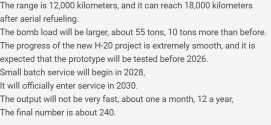Rough translation with no personal comment. You guy could check his credibility though. Source: 两根牙签wxl
Translation:
1. September 19, 2022, No. 6 Prototype was rolled out. No. 5 Prototype was rolled out on 09/27. (Some delay)
2. No. 1 and No. 2 technology demonstration aircraft were completed in the second half of 2016, similar in appearance to the b2, twin-engine, and underpowered, and this design was scrapped.
3. The 3rd and 4th demonstration aircraft were completed in May 2018.
4. Xi'an AVIC completely scrapped the original plan, two years later to adopt WS18. due to thrust insufficiency, bench resonance problems, overturned.
5. No.5 prototype was completely dismantled and the original power plan was rejected.
6. No. 6, using the original design power plan, the construction was completed in September 2022.
7 Production cost is about 3.8 billion yuan for a single aircraft, and no more than 40 aircraft will be equipped. Annual production is 5-6 aircraft.
8 In January 2023, the H20 begins large area fatigue tests and formation flights in the Northwestern China.
9. More details are inconvenient to disclose. (No. 7 has been rolled out, No. 9/10 in preparation for manufacturing.)
Translation: The 5th and 6th prototypes have improved landing gear compared to the 4th prototype. The overall landing gear size has been increased by using stronger steel.
Improved the material of the APU lower fuel guide tube, and the double fuel guide tube was changed to a metal-rubber-metal triple cladding material.
The fuselage material has been improved, using a more conservative proportion of aerospace alloys than in the 4th prototype. The proportion of carbon fiber composite material is less than that of the No. 4, also increased the weight.
Improved engine nickel-based alloy flame retardant bulkhead material and thickness.
The angle of attack detection alarm system was improved, and the freeze and moisture protection devices were added. 6 for the JH-26 and 8 for the Night Owl.
Improved the built-in pumping gas detection and alarm system in the cabin.
Some personal comment here:
I think it is likely that the OP is right on some parts of the H-20 story but JH-26 is one of the IQ detectors when it comes to credibility of Chinese rumor mill here. Anyone who brings up JH-26 and H-20 in a single post, is very likely spreading BS right there.
View attachment 106987View attachment 106988
That would be great if they have 10 stealthy "prototypes" in testing.


